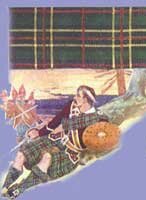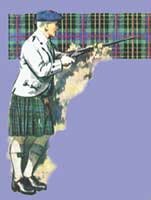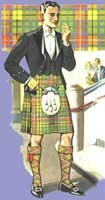|
INTRODUCTION TO THE CLANS OF SCOTLAND
You may ask, why would you need an introduction to something as straight forward as the clans of Scotland ? Well the reason for this is that people assume because their name is Scottish that they are a main clan. This is not always the case. The clans depicted here are the actual original clans of Scotland , but there are many septs of clans which follow on from these. If you look at the clans here as being the main clans of Scotland , then anything else is a branch of these base clans. To list every Scottish clan name and all the different septs/branches would be a huge task and there exists so much controversy about what is and what is not a name associated with certain clans that the job would be almost impossible to bring to perfection. So here you have the main clans. There are many good books available to trace other sept or branch names.
|
|
Click below to find other Scottish Clans
|
|
|
|
|
The Brodie clan derives its name from the Gaelic word Brothach Moreover, has belonged to the Brodies since the beginning of history.
The Brodies are one of the original Morayshire tribes. It has been suggested that the Brodie family clan could be from the Picts. The name itself is similar to the Pictish Royal family who were called � Brude' . It is a known fact that there is signs and evidence of Pictish settlements in the area of the Brodie Clans home range. The diocese of Moray has charter records which use the name Brodie on a regular basis and the name was certainly prominent in the local nobility.
|
 |
| One of the local Brodies was a judge his first name was Alexander. He was summoned to the Lords Council in Edinburgh to explain the reason for one of the sentences he had given out, that was in the year 1484. Another Alexander Brodie of Brodie caused mayhem at Elgin when he attacked the cathedral in 1640 and destroyed paintings and carvings declaring them to be idolatrous. He was also a commissioner and supported the return of Charles the second to Scotland . |
 |
Brodie house was destroyed by fire in 1645 by Lord Lewis Gordon and many of their early charters were lost. The Brodie line of chiefs is deduced from Malcom, Thane of Brodie. This was in the reign of Alexander III. Robert the Bruce created a Barony in 1311 for Michael, son of Malcom, Thane of Brodie.
Lord Brodie Alexander Brodie of Brodie became a well-known and celebrated judge during the reign of Charles II. His descendent Alexander Brodie of Brodie became Lord Lyon King of Arms from 1727-1754.
James son of James Brodie of Spynie became the next heir of Tailzie when his cousin the Lord Lyons Son died having never married.
|
|
The present day Brodie of Brodie is a direct descendent of James Brodie of Spynie.
Brodie castle with its beautiful old fortalice is the seat of the Brodie Chiefs.
The Brodies of Lethen and the Brodies of Eastbourne in Sussex are related to the famous surgeon Sir Benjamin Brodie who received a baronetcy in 1834 and are considered the principal cadets of this clan.
|
|
Chief: Brodie of Brodie
Clan Seat: Brodie Castle Forres
Plant: Periwinkle
Memorials: Kirk of Dyke
|
|
| Back to Top |
| Bruce is of course one of the most famous names in Scotland 's long and sometimes bloody history. History tells us that the Bruce family came from a Norman source and that the name was originally from Adam de Brus. There is a ruined castle still in Brix , Normandy today which belonged to Adam de Brus. He came over to England with William the Conqueror in 1066, and fought at the battle of Hastings . He was a Knight and for his exploits at the battle was awarded vast amounts of lands in Yorkshire . He had a son Robert who decided to move to Scotland along with David the first, and was granted the lands of Annandale , this was in the year 1124. There was a battle in 1138 and history recalls it as the battle of the standard. King David fought against England his former friends. |
 |
|
The fifth Robert the Bruce had married into royalty and produced a son in 1238, he was declared heir to the Scottish throne. This was thrown into confusion when his aunt produced a daughter with her husband John Baliol, and the King had a son born. The daughter would grow up to be better known as the � Maid of Norway ' Robert the Bruce the sixth tried to steal the crown from her but was thwarted. When the Maid of Norway died the Scots appealed to Edward the first of England to become adjudicator as to who would succeed the crown. John Baliol was chosen and Bruce became Chief justice of England . Edward of England decided to get rid of John Baliol and crush the Scots Independence movement started by the truly great Scottish patriot William Wallace. There was a fight when the English forces invaded Scotland . The battle of Dunbar in 1296 saw Edward smash John Baliol's Scottish army.
This left the country without a monarch and the Bruce family were at loggerheads with the Comyns. The Red Comyn and Bruce decided to meet at the border town of Dumfries to see what could be agreed to. The meeting did not go well and a quarrel broke out which resulted in Bruce killing The Comyn in the Church of the Minorite Friars (Greyfriars). This act was to see The Bruce excommunicated from the Catholic Church. Bruce declared himself king and was crowned at Scone soon after that day in 1306. Many people agree that this actually worked out well for the Bruce family. The Knights templar had been attacked in Europe and murdered. The Templars had to flee abroad to save their own lives. Some of the Templars, it is believed came to Scotland because when Bruce was excommunicated so was the whole country. It is said by some people that the Scots armoury was far superior to any they ever had before, thanks to the Templar influence on the forging of the steel.
Twenty-fourth of June1314 saw King of Scots Robert the Bruce defeated a numerically superior English Army at the Battle of Bannockburn. The English were commanded by Edward the second who had succeeded his father in 1307.
The earl of Elgin bears Arms as Chief of the Bruces a Baronetcy created in 1629 and of Downhill in 1804.
|
|
Chief: Earl of Elgin
Clan Seat: Clackmannan Tower , Alloa; Broomhall, Fife
Plant : Rosemary
Tryst: Lochmabenstone, Annandale
|
|
| Back to Top |
|
The Gaelic spelling for Buchanan is � Buth Chanain' and means in English �house of the canon' which is a reference to the possible religious connotations towards the family history.
There were Buchanan religious people in the thirteenth century who served the Celtic Church which makes the Buchanan clan Celts. The Battle-cry of the Buchanan clan is �Clarinch' it originates from an island just of the coast of where they lived. It is from the middle of the 1300s and one Gilbert, Steward to the Earl of Lennox, that the family can trace its ancestry. The name is from the place name of �Buchanan', granted to Gilbert.
|
 |
 |
The Buchanan clan supported Robert the Bruce and were at Bannockburn on the twenty-fourth of June 1314 to help The Bruce defeat Edward the second of England . The English King had arrived with a numerically superior force but could not contest with the Scottish forces fighting power. After the role they had played in the Scottish Independence struggle, the Buchanans faired well. When the French were fighting Henry the Fifth of England in 1421 Sir Alexander Buchanan and other Scottish Nobles fought as part of the French army.
This clan is connected to the Royal House of Stewart by marriage when Maurice Buchanan married a daughter of Menteith of Rusky. Their grandson, Sir Alexander, fought at the Battle of Bauge-en-Anjou in 1421 and slew the Duke of Clarence. It is said that when the fight was over Maurice Buchanan bore off his coronet as a trophy.
|
|
That is the reason for the ducal cap on the family crest. Maurice Buchanan died three years later at the battle of Verneuil and his brother Walter succeeded to the Estates.
One of their descendants was George Buchanan, the detractor of Mary, Queen of Scots, and, subsequently, the tutor of her son King James VI.
An early Jacobite General was born a Buchanan in Aberdeenshire. His name was Thomas Buchan of Auchmacoy. After the sad loss of the great Jacobite leader, Bonnie Dundee, at the battle of Killiecrankie in 1689, Thomas became the leader of James the sevenths forces in Scotland but was beaten in 1690, at the battle of the Boyne , in Ireland by the usurper, William the third of Orange .
Another famous member of the Buchanan clan was one James Buchanan who was the fifteenth president of the United States of America
The eldest line died out in 1682 and representation was then claimed by Buchanan of Auchmar. This line died out in 1816 and the family lands are now in the possession of the Duke of Montrose.
|
|
Chief: Buchanan of that Ilk
Clan Seat: Buchanan Castle , Drymen
Plant: Bilberry
Memorials: Clare Innis, in Loch Lomond
|
|
Click below to find other Scottish Clans
|
|
Back to Top
|